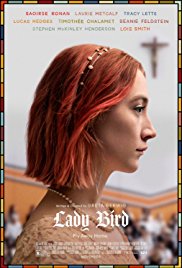Lady Bird – 4/5 – Movie Reviews by Ry!
 Lady Bird – 4/5 – Coming-of-Age films are my favorite. No matter the era, these films always have the purpose to tell the character’s story. In Lady Bird, we have a tale dealing with the true sense in finding yourself with strength and certainty. Even with some convenient plot devices, Lady Bird is another one to add to the catalog of great Coming-of-Age films.
Lady Bird – 4/5 – Coming-of-Age films are my favorite. No matter the era, these films always have the purpose to tell the character’s story. In Lady Bird, we have a tale dealing with the true sense in finding yourself with strength and certainty. Even with some convenient plot devices, Lady Bird is another one to add to the catalog of great Coming-of-Age films.
Premise: An artistic seventeen year-old comes of age in Sacramento, California. With thoughts of leaving her hometown, she must find where her true passion lies.
At the heart of the film is Lady Bird. A nickname she gave herself, Christine McPherson is played by actress Saoirse Ronan. Providing a quirky kind of teenage girl, she goes beyond the clichés and gives the audience a character that is confused in her confines, trying to embrace who she is while living in Sacramento. Tackling varied emotions and twisting it with slick dialogue, you have a down-to-earth teenager that is raw, real, obnoxious but caring. These layers provide stark overtones that the audience can gravitate too. With many decisions birth from random occurrences, you see honest revelations when she is faced with hard moments. With the oddities in her personality, you see the poignant detail found in the authentic approach. Through it all, Ronan does a great job providing humanistic appeal to a fictional character. For the rest of the cast, I would recommend referring to the film’s IMDb page. Out of the secondary characters, the following stand out:
Laurie Metcalf as Marion McPherson (Mother)
Tracy Letts as Larry McPherson (Father)
Beanie Feldstein as Julie Steffans (Best friend)
These three do a comparable job as Ronan. Adding varied dimensions to the lead’s characterization, these three provide the angst, love and confrontation that happens with Lady Bird. From the mother/father angle to the best friend dynamic, you see the typical attributes pushed to a humanizing experience. In this you get a genuine touch that creates depth and honesty to their flawed personalities. With the indifference in all three characters, it provides layers to their relationships, interactions and consequences that happen. Through the thick and thin, you can see their purpose in the film. The other secondary characters are good throughout the story, but are basic archetypes to the Coming-of-Age genre.
The direction takes the path of many similar films, where it flows in a linear fashion with the story’s focus on general characterization. What makes these films good or bad is how much they follow this outline. Having a standard focus will create an average experience, but if you add that ‘heart’ (no matter topic, character or era), you will be able to find something moving in the detail. In the vein of films like The Edge of Seventeen and The Perks with Being a Wallflower, Lady Bird takes a creative twist in providing a focus on characterization through interactions and strong dialogue. Flowing in a manner of just living in her footsteps, you get a fluid balance between the themes of ‘relationships, drama and self-discovery’. Changing around the traditional linearity progression, the director unfolds the common tropes of high school, teenager/parent drama and ‘who am I?’ with unpredictable trends. There are delicate threads to how characters interact by providing something honest, raw and energizing. There is a sense of not knowing where the story is going, allowing revelation with certain characters to be welcomed with a shocking eye. As we watch Lady Bird traverse the final year of high school, there is angst with wanting to stay close to home for college or leave for the East Coast. Balancing these dynamics, you see a character that is conflicted, lost, but focused. This reverberates throughout the rest of her family and friends, seeing the nature of her personality flourish in unorthodox ways. Slowly, you are given thematic and personal exposition through her eyes. Once the film brings the dangling threads together into the final act, there is a turn back to the traditional Coming-of-Age tropes. The predictable ‘wrap up’ scenes make the final stretch slightly anti-climactic. The subtle imprints built up are left unexplained, leaving the obviousness to obscure the endearing details of Lady Bird’s final decisions. Even with this slight let down, the epilogue ends the story with the genuine touch of where the heart of film belongs.
The cinematography is the basic aesthetic of suburbia in the 21st century. The film’s visuals add to the aura of the genre, giving a contrast to the ongoing characterization of Lady Bird. Even when everything is simple, it provides the background for everyone to grow in a relative environment. The score has strong moments, but never completely enraptures the story and evolving characters.
Lady Bird is another great Coming-of-Age film. Even with some predicable beats near the end, the film’s strength lies within the overall story of the titular character. If you are a fan of these kinds of films, this is one for you. I say it is worth the full price, worth going with friends to relive them high school days.